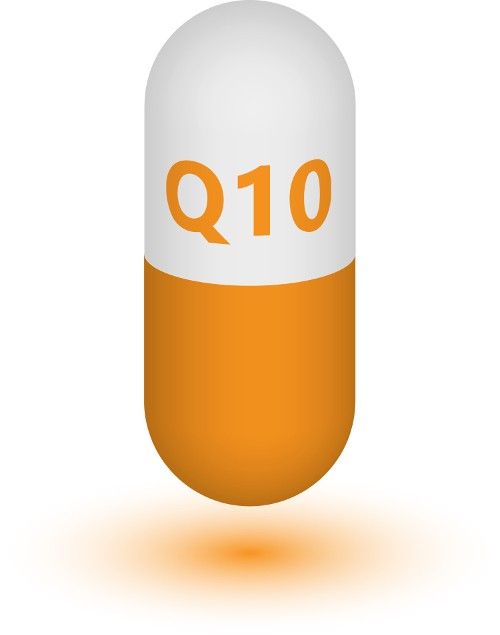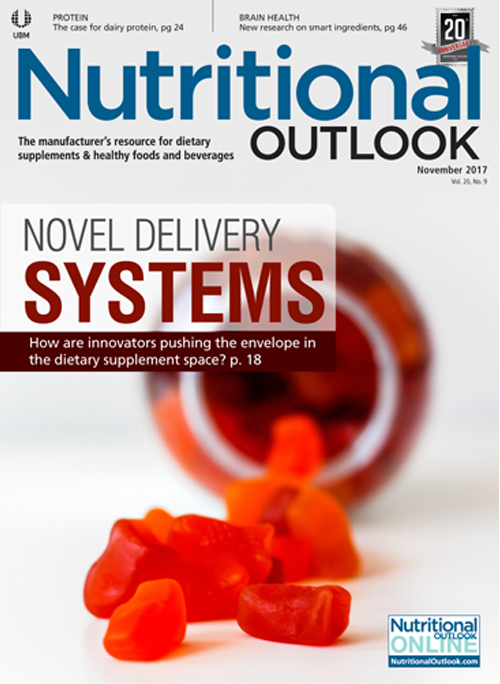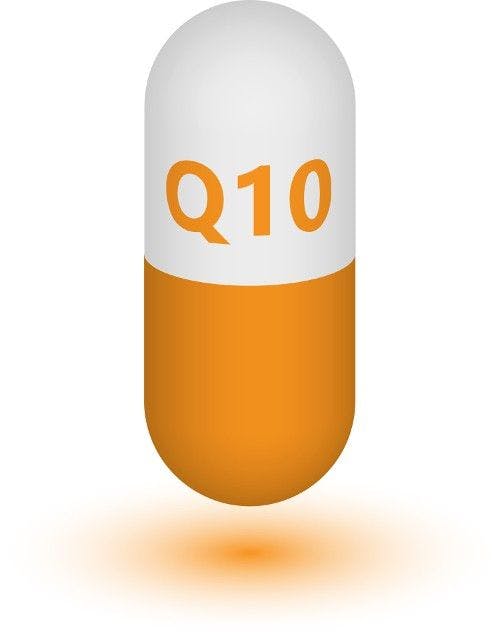CoQ10: An Update on an Old Standby
A look at why CoQ10 has remained a go-to heart health ingredient for decades.
Photo © Shutterstock.com/Grey ibex

In the nutritional-supplements industry, ingredient fads come and go, waxing and waning in popularity and media attention. Some ingredients, however, earn the respect of consumers, physicians, journalists, and scientists alike, and retain their good reputation indefinitely. Coenzyme Q10 (CoQ10) is one such ingredient.
Discovered in 1957 and finding a solid foothold in the supplements market within the last 15–20 years, CoQ10 “is one of the most studied-and more importantly, understood-dietary supplements” on the market today, says Scott Steinford, executive director at large of the CoQ10 Association (Salt Lake City, UT).
He explains that the human body synthesizes CoQ10, but our production of this fat-soluble compound declines as we age. “CoQ10 is utilized by every cell of the human body and is an intricate contributor to the ATP process,” Steinford continues. “In simplest terms, CoQ10 is responsible for converting food into energy. The effects of CoQ10 deficiency are most noticed in the organs that require the most energy production.” These organs include the liver, kidneys, and, of course, the heart.
“Thousands of studies have demonstrated the activity and importance of CoQ10 in heart health and many other human and veterinary health aspects,” Steinford contends, and demand for the ingredient seems to be in line with that assertion. “A 2017 ConsumerLab.com survey of more than 9,500 respondents listed CoQ10 as the third most popular dietary supplement behind vitamin D and fish oil,” Steinford points out.
What’s more, some research has suggested that this ingredient holds promise for other emerging areas such as oral health. “The pharmacology of coenzyme Q10 indicates that it may be an agent for treatment of periodontitis,” say Shobra Prakash and co-researchers in the Indian Journal of Pharmacology, and “coenzyme Q10 may possibly be effective as a topical and/or systemic role or adjunctive treatment for periodontitis either as a stand-alone biological or in combination with other synergistic antioxidants (i.e., vitamins C and E).”1
As such, “we are seeing strong sales growth in the natural channel in toothpaste with CoQ10 as an active ingredient,” says Jamie Phillips, director of scientific affairs at SPINS (Chicago, IL). While sales are relatively small, SPINS natural products specialist Kimberly Kawa states, “Sales in the Oral Care category within the Body Care department are up about 7%,” with Nature’s Answer’s PerioBrite toothpaste (a brightening formula with CoQ10 and folic acid) leading the way.
CoQ10 by the Numbers
In the Vitamin, Mineral, and Supplements category only, total sales of CoQ10 for the 52 weeks ending August 13, 2017 were roughly $164 million, down slightly (about 2%) from the previous year, while sales of ubiquinol (i.e., the fully reduced form of CoQ10) were up 1.3% from the previous year, according to the most recent SPINS data available. The slight downward trend of conventional CoQ10 (i.e., ubiquinone), says SPINS’ Phillips, is likely due to the fact that “it is an established supplement” with “no new news or marketing messages” in recent months.
As for ubiquinol, “it is more expensive than [ubiquinone], but has been found to be more effective for persons with certain conditions that inhibit the necessary conversion of CoQ10 in the body,” Kawa notes.
CoQ10 Association’s Steinford adds that ubiquinol is gaining popularity with consumers who are concerned with absorption and bioavailability; however, “ubiquinone [CoQ10’s fully oxidized form] still commands 90% of the overall CoQ10 market and remains the most recommended form of CoQ10,” he says.
Among physicians, CoQ10 has earned trust and confidence, too. A CoQ10 Association study of 100 cardiologists found that CoQ10 was the most-recommended supplement among this group and that 71% of cardiologists recommend the ingredient to “at least some” of their patients.
Dosing and Delivery
Demand for CoQ10 is on the rise. “In 2000,” Steinford says, “the global demand for CoQ10 was 37 metric tons, while in 2016, the global demand for CoQ10 exceeded 750 metric tons.” One reason for this significant uptick, he explains, is that the typical dosage increased from 5 to 30 mg in 2000 to about 120 mg today. He adds that the even higher 200-mg CoQ10 dosage is the fastest-growing one.
Vincent Tricarico, vice president of contract manufacturing at NutraScience Labs (Farmingdale, NY), says he is noticing CoQ10 in a “growing variety of formulations” beyond those for traditional cardiovascular support, including vision-support and antioxidant-specific formulations.
As for delivery systems, Tricarico says an oil-based liquid contained in either softgels or “standard two-piece veggie or gelatin capsules” is best. Steve Holtby, president and CEO of Soft Gel Technologies (Commerce, CA), agrees, specifying that fat-soluble CoQ10 is absorbed more readily when “placed in lipid media such as softgels or when taken with foods containing fat. A softgel delivery system plays a key role in enhancing the effectiveness of CoQ10 getting into the bloodstream,” he says.
“CoQ10, being a highly lipophilic and crystalline material, presents specific challenges that require an innovative approach,” Holtby continues. “Absorption [by the body] is dependent on the number and size of CoQ10 crystals within the product.” (The fewer and smaller the crystals, the better.)
He describes how Soft Gel Technologies’ CoQsol-CF formulation dissolves CoQ10 in solution, resulting in a “completely solubilized CoQ10 that does not require heat or synthetic solvents,” and the mixture “fully resists recrystallization at ambient temperature ranges.” By improving dissolution, he asserts, absorption is enhanced.
CoQ10 and Fish Oil
For those looking to break into the heart-health supplement space, combining CoQ10 with omega-3 fatty acids “can serve as a great starting point” for a heart-health formulation, says NutraScience Lab’s Tricarico.
The CoQ10 Association’s Steinford agrees, citing a July 2017 study investigating the effect of a CoQ10 and omega-3 fatty acid combination on statin therapy in some heart patients, in which the researchers reached the conclusion that “the results of this pilot study suggest the possible beneficial effects of triple combination [statins, omega-3s, CoQ10] on the lipid and non-lipid parameters related to atherogenesis and side effects of statin treatment.”2
Tricario adds: “Viewing omega-3 fatty acids and CoQ10 independently, there is ample evidence to suggest the combination of the two ingredients will collectively work to improve heart health.”
CoQ10 supplementation is commonly recommended by physicians as an adjunct to statin therapy; the fact that CoQ10 levels in the body are reduced when a patient takes statin medication is widely known. “Given that it’s also common to take an omega-3 supplement with a statin,” says Harry Rice, PhD, vice president of regulatory and scientific affairs at the Global Organization for EPA and DHA Omega-3 (GOED; Salt Lake City, UT), “then an omega-3 and CoQ10 combination product makes perfect sense.”
One such product is Fish Oil Q from Carlson Labs (Arlington Heights, IL), launched in 2007. “Carlson was the first company to introduce an oil-based CoQ10 way back in the 1980s,” says nutritionist and educator Jolie Root of Carlson Labs, “so it was a natural progression to combine omega-3s and CoQ10 in one formula.” She echoes GOED’s Rice, stating, “Since fish oils are routinely prescribed as secondary prevention of heart events in persons with known heart disease, who are also likely to be taking statins, the combination just makes perfect sense.”
Nordic Naturals (Watsonville, CA) also offers combination omega-3–CoQ10 products, including its Ultimate Omega+CoQ10 softgels, which contain fish oil and the ubiquinone form of CoQ10; and its Omega LDL, which is formulated with concentrated omega-3 fish oil, ubiquinone, and red yeast rice.
Nordic Naturals is now also offering a ubiquinol softgel containing 100 mg of a ubiquinol ingredient from Kaneka Nutrients (Pasadena, TX) in extra-virgin olive oil. “We expect to see ubiquinol implemented in many more formulations, including with omega-3s, for consumers among the baby-boomer generation,” says Kaneka North America’s product-development manager Sid Shastri.
“In many ways, ubiquinol and omega-3s are ideal partners in the battle for cardiovascular health. While ubiquinol is a potent lipid antioxidant that is active in the production of cellular energy necessary for the heart and other energy-intensive organs to function efficiently, omega-3s are valued for their impact on reduction of blood lipids, particularly triglycerides as well as blood-platelet functionality and vasodilation,” he states. “By reducing blood lipids and protecting against oxidation of lipids (which then penetrate into vascular arterial intima-an important initiation point in the pathophysiology behind atherosclerosis), there is ample rationale for the combination of these two cardio-protective nutrients.”
The Future of CoQ10
While ubiquinone reigns supreme among CoQ10 sales, interest in ubiquinol is building. Shastri of Kaneka North America, notes that “as consumers over 40 years of age become more educated about ubiquinol, as opposed to conventional CoQ10, they have come to appreciate the value of ubiquinol in the production of cellular energy as they age.”
He adds, “The knowledge base of manufacturers has greatly increased over the last ten years from ubiquinol’s launch; therefore, we are at the starting point of seeing ubiquinol-anchored formulations proliferate in the market.” Brands selling supplements made with Kaneka QH ubiquinol include NOW Foods, Puritan’s Pride, Jarrow Formulas, Doctor’s Best, Life Extension, and Healthy Origins.
Also read:
CoQ10 for Dietary Supplements Market Update
Omega-3, CoQ10 May Benefit Prostate Health, Study Shows
References:
- Prakash, S et al. “Role of coenzyme Q10 as an antioxidant and bioenergizer in periodontal diseases.” Indian Journal of Pharmacology, vol. 42, no. 6 (December 2010): 334-337
- Tóth, Å et al. “Addition of omega-3 fatty acid and coenzyme Q10 to statin therapy in patients with combined dyslipidemia.” Journal of Basic and Clinical Physiology and Pharmacology, vol. 28, no. 4 (July 2017): 327-336

Prinova acquires Aplinova to further increase its footprint in Latin America
April 7th 2025Prinova has recently announced the acquisition of Brazilian ingredients distributor Aplinova, which is a provider of specialty ingredients for a range of market segments that include food, beverage, supplements, and personal care.




















